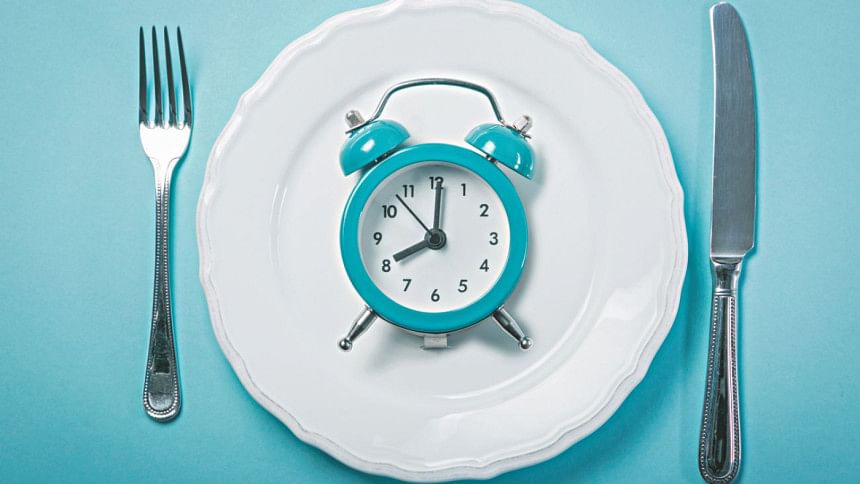Intermittent fasting- the new diet planner in town

Intermittent fasting, as the name suggests, is a dieting scheme or plan which involves a period of eating, followed by a period of not eating, repeated over time. Of course, water is consumed during the fasting period, including fluids like fruit juices, tea, coffee etc. but, without sugar, or very small amounts of sugar, preferably less than 50 calories.
There are three types of intermittent fasting-
Whole-day fasting: For one to two non-consecutive days per week, you consume just water plus 500 calories, (200 of which are protein), either in one meal or spread out over the day. The other five or six days a week, you can eat whatever you want, whenever you want (though we obviously encourage that to be mainly fruits, vegetables, lean protein, and whole grains).
Alternate-day fasting: For the first 24 hours, consume just water plus 500 calories, (200 of which are protein), either in one meal or spread out over the day. For the second 24 hours, you can eat whatever you want, whenever you want. Repeat the cycle every two days.
Time-restricted feeding: Every day, you fast for 16-20 hours, drinking nothing but water or zero-calorie tea. Then, you eat whatever you want, all within a four to eight-hour window, like 10 AM to 6 PM or 12 PM to 8 PM (most people opt for an eight-hour feed option).
People choose one from the above three depending on their body type, BMI, lifestyle, daily routine, work load, leisure hours per week, climate where they live, age, etc.
It's wise to consult a nutritionist or dietician to decide which form suits you best than to just decide for yourself.
Intermittent fasting is being preferred over the usual 'dieting' or calorie restriction because it brings certain advantages with it. Unlike calorie restriction, intermittent fasting does not require you to legit starve yourself. In calorie restriction, one greatly reduces his or her intake of food. This slows down the body's usual metabolism, which may have side effects on the body. You feel exhausted, drained. Plus, intermittent fasting is better at preventing hunger because you are taking food at regular and fixed intervals.
Furthermore, intermittent fasting is especially good at helping you lose fat while maintaining muscle, rather than losing both (as you would with traditional calorie restriction), says Krista Varady, Ph.D., an associate professor of kinesiology and nutrition at the University of Illinois at Chicago and key researcher on intermittent fasting. According to a study analysis in Nutrition Reviews, intermittent fasting also helps improve total cholesterol and triglyceride levels in both overweight and normal-weight people. The best part: There's virtually no downside.
When people lose weight, typically 75 percent is fat loss and 25 percent is muscle mass. But with fasting, the ratio actually changes so that 90 percent of weight loss is fat and 10 percent is muscle. And because you retain this muscle, your metabolism won't drop the way it might with calorie-restricted weight loss. In fact, fasting actually boosts your metabolism. Plus, time-restricted feeding can help control cravings better than when someone is on calorie restriction (the mere utter of food makes you want to pounce on it).
Here are some of the food items you should take when on intermittent fasting to make it more effective:
Avocados: The monounsaturated fat in avocado is extremely satiating. A study even found that adding a half of an avocado to your lunch may keep you full for hours longer than if you didn't eat this green gem.
Fish: They are not only rich in healthy fats and protein, but also contain ample amounts of vitamin D. Not to mention that limiting your calorie intake may mess with your cognition, and fish is often considered a "brain food."
Cruciferous veggies: Vegetables like cauliflowers, broccoli, sprouts and any other green leafy vegetable, are rich in fibre. When you're eating erratically, it's crucial to eat fibre-rich foods that will keep you regular and prevent constipation. Fibre also has the ability to make you feel full, which is something you may want if you can't eat again for 16 hours or so.
Probiotics: You know what the little critters in your gut like the most? Consistency and diversity. That means they aren't happy when they're hungry. And when your gut isn't happy, you may experience some irritating side effects, like constipation. To counteract this unpleasantness, add probiotic-rich foods, like yoghurt, tempeh, kimchi, miso, kombucha, pickles, etc.
Berries: Your favourite smoothie addition is ripe with vital nutrients. Strawberries are a great source of immune-boosting Vitamin C, with more than 100 percent of the daily value in one cup. And that's not even the best part—a recent study found that people who consumed a diet rich in flavonoids, like those in blueberries and strawberries, had smaller increases in BMI over a 14-year period than those who did not eat berries.
Whole grains: Whole grains are rich in fibre and protein, so eating a little goes a long way in keeping you full.
Water: Drink lots of water to keep yourself hydrated.
During your feeding period, you can eat whatever you want to. As losing weight is your primary goal, try to avoid rich food, like a cheese burger or yummy pizza. Instead, try to have healthier and lighter foods which will keep you active throughout the day. You can obviously eat your favourite junk food items, but to a limit.
Don't think of 'rewarding' yourself for not eating for so long by giving yourself free access to all sorts of junk food. Control! Satisfy your taste buds, but don't be too lenient on them.
Keep some things in mind when trying this diet out. The first two weeks will be VERY tough, no matter which sort of fasting you choose. The body will take time to get accustomed to this new routine. You will have to fight your cravings. You will have to resist the sight of those mouth-watering food your friends, family or co-workers are indulging in. You may feel exhausted at times. But, if you are strong mentally and are determined, then you will survive the first two weeks of your 'test and endurance'.
After that, things get much easier and will come into a flow, and eventually, will become part of your lifestyle.
Photo: Collected

 For all latest news, follow The Daily Star's Google News channel.
For all latest news, follow The Daily Star's Google News channel. 




Comments